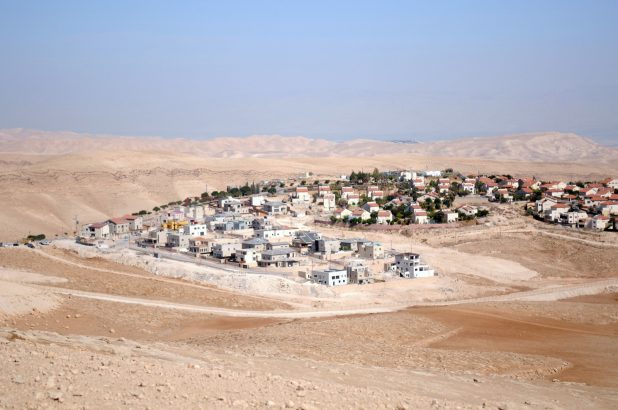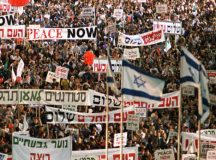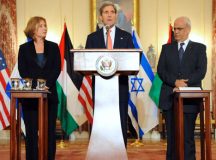One reason for the foundering of the recent Israeli-Palestinian peace talks was the failure of the parties to agree the line of the border separating Israel and a Palestinian state. David Newman examines the history of the border question, the key factors involved in reaching agreement, and brings to light challenging new proposals for ‘extra-territorial exclaves’, that may have to be considered for a two-state solution to remain viable.
Israel’s Boundaries
Israel has five potential land boundaries with neighbouring states – with Lebanon, Syria, Jordan, Egypt and a future Palestinian state (not including maritime boundaries that it also shares with Cyprus – and hence the European Union). Only two of these boundaries – with Egypt and part of the boundary with Jordan – have the legal status of international boundaries, resulting from the formal peace treaties which have been signed between Israel and these countries, as recently as 1979 (Egypt) and 1994 (Jordan). The respective treaties included a clear and final delineation of the boundaries between the neighbouring states on maps which were included as an annex to the agreements.
In the case of the peace treaty with Jordan, the latter only agreed to ratify the course of the boundary from the Eilat/Aqaba northwards to the southern point of the West Bank, and then again from the northern point to the tri-border meeting of Jordan, Syria and Israel. Jordan refused to ratify the course of the line along the part of the Jordan Valley which lies within the West Bank, arguing that this was for a future independent Palestinian state to determine.
Prior to the signing of these peace agreements, all of Israel’s boundaries were no more than armistice lines which had been demarcated between Israel and the neighbouring countries in the talks which took place between Israel and each of her neighbours in Rhodes, following Israel’s War of Independence in 1948-49. Since no peace agreement has yet been entered into between Israel and Lebanon or Syria, the formal status of the borders has not changed. In the case of Lebanon, the course of the line is clear and it only remains to be ratified in a future agreement (with the minor exception of the Shebaa Farms). This was clearly indicated when Israel withdrew from South Lebanon in 2000, to the accepted line of demarcation between the two countries. In the case of Syria, the armistice line is the pre-1967 line, under which the Golan Heights are part of Syria, not Israel. This remains a major point of contention between the two countries and will figure prominently in any future negotiations, if they are ever to take place.
Demarcating the Israel-Palestine Border
The default border line between Israel and a future Palestinian state is widely regarded to be the Green Line, which formally separates Israel from the West Bank and which was also drawn up in the 1949 Rhodes Armistice Talks, negotiated between Israel and Jordan. The border, which was the first formal political division of territory between the Jordan River and the Mediterranean Sea, reflected the outcome of the war and, along with some adjustments – especially in the Wadi Ara region enabling Israel to maintain a territorial link between the coastal towns and Afula – was superimposed upon the landscape. This was far from satisfactory as far as the Arab-Palestinian population were concerned. The imposition, and closing, of the border effectively created separate Arab-Palestinian populations and societies. Those remaining on the Israeli side of the border became Arab citizens of Israel, making up approximately 20 per cent of the country’s population, while those on the other side of the border, within the areas now known for the first time in history as the West Bank and Gaza Strip, became stateless Palestinians, initially under Jordanian and Egyptian administration (1949-1967) and subject to Israeli rule following the Six Day War.
Palestinian claims to a sovereign territory focus on the demand for a state established on ‘the borders of 1967,’ namely the Green Line. They see this as constituting a minimalist demand as they no longer lay claim to the rest of Mandate Palestine (over 70 per cent of the territory which now constitutes the State of Israel). For Israel on the other hand, the calls for a return to the Green Line are perceived as being a maximalist demand, arguing that the Palestinians should be prepared to ‘compromise’ over some parts of that territory, given the geographical and demographic changes that have taken place in the 45 years which have passed since the 1967 War, most notably the construction of Israeli settlements throughout the West Bank.
Five key factors have influenced the ongoing border negotiations during the past 20 years: The original Green Line; the impact of the separation barrier; the role of Israeli settlements in determining the line of the boundary; the proposal for land swaps as part of boundary re-demarcation; and, most recently, the idea of territorial exclaves remaining on each side of a future boundary.
(i) The Green Line
The Green Line, separating Israel from the West Bank, was drawn as an armistice line immediately after the country’s War of Independence in 1948-1949, following the Rhodes armistice talks which took place between Israel and Jordan. The Line largely reflected the position of the respective troops at the cessation of hostilities. The course of the Green Line remained the official line of separation between Israel and the West Bank. Since 1967, Israel has constituted the occupying power throughout the West Bank, such that the Green Line was relegated to the status of an internal administrative boundary between sovereign Israel and those territories under occupation and governed according to the Civil Administration of the military government.
The Green Line was called as such because of the green pen which was used to draw the line at the Rhodes talks and which was the subsequently used on all official Israeli maps. Despite the fact that successive Israeli governments pronounced the demise of the Green Line, and for a lengthy period of time removed it from all official maps, atlases and school geography texts, the Green Line remained the formal line of separation between the two territorial entities, with or without fences and border guards. No Israeli government attempted to annex the newly acquired territories to the State of Israel (with the notable exception of East Jerusalem) and the laws for the civilian administration of the Palestinian population residing inside the West Bank (and Gaza Strip), remained different from the Israeli side of the border. Israeli citizenship rights were not granted to the Palestinian residents. Internationally, this continues to be considered the border even though the territory east of the Green Line is not formally recognised as falling under the formal jurisdiction of any single authority.
(ii) The Separation Barrier
The construction of the separation barrier was, first and foremost, a unilateral Israeli response to the worsening of its national security and the infiltration of suicide bombers from the West Bank and Gaza into Israel’s main population centres. This barrier, in part electronically monitored fence, and in part concrete wall (especially in urban areas) is true to the course of the Green Line for approximately 70 per cent of its length, deviating from the line mostly in those areas where the government has desired to keep large Israeli settlement blocks on the Israeli side of the line. Many of these demarcation deviations have been ruled as illegal by both the International Court of Justice and the Israeli Supreme Court and have, in some areas, had to be redrawn. In no case has the line deviated to the west, inside Israel, meaning that all such modifications have effectively created small areas of land which have a border both to the west (Israel) and to the east (the West Bank).
Many Israelis encounter the separation barrier as they drive through Jerusalem or along the Trans-Israel Highway. Because of this visibility, the vast majority of Israeli citizens, who never travel into the West Bank either out of fear for their personal safety or because they are opposed to driving into what they perceive as illegally occupied territory, are now more aware of the existence of a border and what this means in the eventuality of a two-state solution to the conflict. Five distinct border crossing points have been constructed along the course of the separation barrier, at which point travellers have to show their documents or be recognised as bona fide travellers to pass from one side to the other.
For their part, Palestinians encounter the barrier as a border which limits their freedom of movement to pass from the West Bank into Israel. They require special permits to enter Israel and cars with Palestinian license plates are not generally allowed beyond the border. (Israelis do not require any special documents to enter the West Bank, except for the main Palestinian population areas, known as Area A, which are under Palestinian control and off limits to most Israelis.)
Although the separation barrier has effectively transformed into an international border, with sophisticated surveillance technology and a limited number of crossing points, its initial rationale was, as far as the vast majority of Israelis were concerned, to prevent terrorists from entering Israel. It is for this reason that it enjoyed the support of most Israeli citizens, regardless of their positions along the right-left political spectrum. It was initially implemented by a right-wing Prime Minister, Ariel Sharon, who had previously been opposed to constructing a physical barrier, precisely because it would create a line of physical separation which would be automatically construed as being a political border, but not in the location that he would have chosen. However, the constantly heard argument by all leading Israeli politicians, including the respective prime ministers that this is ‘not a political border between two states, but just a security barrier’ is difficult to accept when encountering the procedures required for crossing from one side to the other.
(iii) The Impact of Settlements on Border Demarcation
When the pro-settler movement began to construct settlements in the West Bank in the late 1960s and then again after the Yom Kippur War, under the leadership of the Gush Emunim movement, their objective was to create a situation where the ‘facts on the ground’ made it impossible to undertake any future territorial withdrawal. The assumption was that no Israeli government would forcefully remove Jewish settlers as this was in opposition to the Zionist ideal which had guided the earlier generations of kibbutzim and moshavim in laying claim to the land and expanding areas under Jewish control.
Notwithstanding, by the time of the signing of the Oslo Accords in 1993 and 1995, despite the rapid growth of the settlements during the previous 20 years, it became clear that the wider Israeli public was prepared to undertake territorial withdrawal and that they would not give up the chance of peace for the sake of a Greater Israel. For a short time, the settler movement faced defeat and acknowledged the fact that their dream of extending sovereignty throughout the West Bank would not materialise.
The widespread dispersal of settlements meant that it was difficult to draw borders which would create compact Israeli and Palestinian territories. Settlements became the basis for exclaves, enclaves, territorial discontinuity and safe passage roads, thus fragmenting the area into small pieces of unmanageable territories. As the growth and construction of settlements continued, even in the post-Oslo period, so the ability to draw borders became increasingly difficult to implement. Even without the dream of a Greater Israel, the settlements did indeed become a major obstacle to implementing a territorial separation along the lines of a two-state solution, with facts on the ground preventing any form of territorial continuity without forceful evacuation of a significant number of settlements.
(iv) Redrawing the Border and Land Swaps
Notions of territorial exchange and land swaps, ideas which would have seemed fictional to the average Israeli as recently as the period of the Oslo Agreements in the mid-1990s, have now become a central part of the discussion about borders. This is based on the idea that if Israel were to demand the redrawing of the border in such a way as to annex anywhere up to 10 per cent of the West Bank to Israel, the Palestinian state would have to be compensated by an equal amount of land on the Israeli side of the border.
In numerous Track II discussions over the past decade, two areas of potential exchange along the course of the Green Line between Israel and the West Bank have been identified, with vastly different political and demographic significance for both Israel and a Palestinian state. The area south of the Green Line, south of Qiryat Gat and bordering on the Be’er Sheva and Hebron Hills region, is largely unsettled, although there have been attempts to bolster the Jewish presence in this region during the past two decades. This is also an area where the country’s growing Bedouin population (roughly estimated to be approximately 200,000 at the beginning of 2011) is concentrated. Cross-border links between the Bedouin population inside Israel and the Palestinian residents of the southern parts of the West Bank exist, although this has become increasingly difficult with the construction of the separation barrier.
The second area of potential swaps to have been identified is in the northern section of the West Bank. Unlike the relatively unsettled southern area, the northern region consists of a dense population of Arab-Palestinian citizens of the state of Israel, including such major towns as Um el Fahm and Tayibe, and numerous smaller townships and villages. Some right-wing politicians within Israel, principally Foreign Minister Avigdor Lieberman, have proposed land swaps that would include some of the Arab towns and villages inside Israel. In this way, they would even further reduce the percentage of Israel’s Arab minority population (currently about 20 per cent) and implement their own policy of ‘transfer’ without actually having forcefully to evacuate a single resident. This is considered a total non-starter by the Arab-Palestinian population who oppose any form of ‘silent’ transfer through the manipulation of borders.
Whatever the configurations of a land swap, there will always be a significant percentage of Israeli West Bank settlements that remain on the ‘wrong’ side of the border. Approximately a third of the Israeli settlements (approximately 100,000) would remain on the Palestinian side and would have to be evacuated by the Israeli government or remain under some arrangement within the borders of a Palestinian state. Not only is this a large number, but it consists of the most ideologically-oriented groups among the settler population, those who settled in the region out of a strong historic or religious belief that the land belongs to them by right. This contrasts with those settlers who came because of the economic incentives such as the cheap houses or low interest mortgages which have been offered to Israeli residents by right-wing governments as an incentive to get them to relocate beyond the Green Line. There is a geographic paradox here, in that many of the settlers who would be prepared to evacuate voluntarily, if and when they were offered adequate economic compensation, would not have to relocate because the border changes would leave their settlements inside Israel. However, those who would likely refuse to relocate, and may have to be forcefully evacuated, are mostly located in those areas which, under any form of territorial redrawing of the borders, would remain on the Palestinian side of the line. This is one of the major difficulties for any Israeli government in moving ahead with the implementation of a two-state solution.
(v) Exclaves and Cross-Citizenship
Recently part of the public discourse is the idea that, given the inability of even land swaps to bring about acceptable conflict resolution, some settlements could remain as extra-territorial exclaves surrounded by the territory of the other state. This has recently been discussed in a Hebrew University project of the Shasha Center, headed by former Mossad director Efraim Halevy. Citizenship would be based on the national and ethnic affiliation of the community rather than on their geographical location. In theory, this would enable the management of the two-state solution with the minimum of physical dislocation or relocation of peoples and could, ostensibly, stretch to peoples on both sides of the border.
However such a solution would mean that the territory controlled by each of the two entities – Israel and Palestine – would not be compact or contiguous (and this is not even referring to the problem of the land link between the West Bank and Gaza Strip, which would remain a problem under any form of territorial division). It was the territorial fragmentation into Areas A, B and C under the Oslo Agreements which led to many of the post-Oslo problems, since when the necessity for each state to control a clearly defined, compact piece of territory, has always been uppermost in the thinking of all negotiators.
At this time in writing, this has not been developed beyond a general idea and, for many, it appears to be quite untenable. It raises a whole host of questions which have not yet been addressed, such as the functional nature of the borders (open or closed), freedom of movement and passage beyond borders, as well as the respective location of security forces and policing of the two populations. A solution based on ethnic exclaves may, on the one hand, solve problems of settler evacuation and citizenship rights, but would equally create a potential situation of instability which could lead to a further breakdown of the process.
Nonetheless, as time moves on without a resolution of the conflict, so the facts on the ground create new situations which require new solutions, often involving thinking outside the traditional territorial box. The discourse about the border continues to evolve, reflecting the changes in the conflict itself. A return to the default Green Line involving the evacuation of hundreds of thousands of settlers, appears almost impossible to achieve, even by a strongly pro-peace Israeli government. Equally it is difficult to envisage any form of final agreement without bilaterally agreed borders between the two sides.






































Comments are closed.